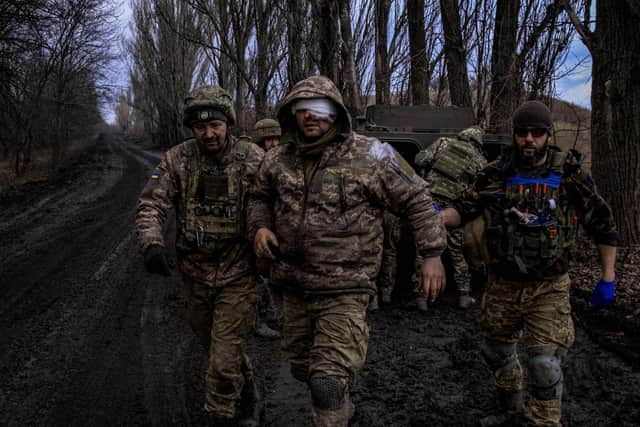Minor victories could leave either side spent and brittle in Ukraine war - Patrick Mercer
First, it’s time for my regular cautionary note: be careful of what you read or watch, for both Russia and the West are not above being economical with the truth in this war.
Essentially, since 2014 Ukraine has prepared three major defensive lines in the Donbass under Western supervision and the first two, at least, are like latter-day Maginot Lines.
Advertisement
Hide AdAdvertisement
Hide AdWith the fall of Severodonetsk and Lysyshansk last summer, the Russians broke through the first line, but their casualties and expenditure of ammunition and materiel was so great that they exhausted themselves. Indeed, so depleted were they that two Ukrainian counter offensives recaptured great swathes of the occupied lands in the north and south west of the theatre - although that effort took a huge toll on the Ukrainians.


Then, after a pause, Moscow’s men started low key operations against the main fortresses on the Zelensky Line, the next layer of defence. Weeks passed; Russian progress was slow but especially bloody for Kiev until just as the New Year broke when Soledar fell and the tempo of offensives moved up a gear. Many pundits, including Kiev’s high command, predicted that the assaults across the length and breadth of the Zelensky Line were simply ‘shaping’ operations for a much bigger, sweeping attack by President Putin’s refreshed and reinforced army and air force, but this has yet to happen.
In truth, Moscow has never suggested that the ‘big push’ was in the offing, instead her men concentrated on the brutal, house to house fight for Bakhmut. Now, the Pentagon has been fond of claiming how strategically unimportant Bakhmut is to Kiev and that its loss would not noticeably change the Ukrainians’ position.But, last Tuesday, President Zelensky and his generals announced that they would grimly fight on for the battered town - which is now almost encircled by the Russians - giving the lie to its tactical insignificance. I fear this is nonsense: Bakhmut is the Ukrainians’ Cassino and its loss would be tactically serious, but almost disastrous both politically and for morale.
There may be a clever plan here, though. Until the Kremlin ordered an all out assault on Bakhmut, her troops’ casualties had been a fraction of the Ukrainians’ dead and injured. The devastated little town was described by some as the anvil upon which the Russian hammer fell upon Kiev’s forces, yet things have changed over the past weeks.
Advertisement
Hide AdAdvertisement
Hide AdAttacking infantry and tanks have been destroyed in large numbers to the point where it’s possible to imagine that Kiev is not only killing many of their enemies in Bakhmut, but also pinning Russian reserves there and, perhaps, setting conditions for her own offensive in the south towards the coast of the Azov Sea.
There’s also a much bigger political point at stake for Kiev. It’s suggested that the main reason that President Putin has stuck to his ‘Special Military Operation’ rubric and been cautious with the lives of his troops is that his regime cannot afford big ticket casualties. A quick glance at Russian conflicts from the Crimea in the 1850’s through the butchery of the First World War right the way up to Afghanistan thirty years ago, shows chaos and revolution following disastrous military adventures. Kiev knows that this is President Putin’s Achilles heel: perhaps, she is resigned to losing many of her own men in Bakhmut if it means a drawn out decimation of her enemy and subsequent political upheaval in Moscow.
There’s another couple of twists to this story, though. President Zelensky has said before that towns on Ukrainian soil will never be surrendered and then promptly withdrawn - and I expect something similar with Bakhmut. But after such a victory, Russia will again be drained and facing another great line of redoubts and trenches 25 miles west anchored on Kramatorsk and Slovyansk.
In military theory a force which has won a minor victory is always spent and brittle. So, confronted only by tired troops and depleted reserves, Kiev will be itching to return to the offensive once Bakhmut falls - and this is exactly what President Zelensky is signalling that he will do.
Advertisement
Hide AdAdvertisement
Hide AdNow Ukraine is telling the world that she intends to cut the ‘land bridge’ - the captured corridor that links Crimea to Mother Russia - severing the whole of Moscow’s army, isolating Crimea and making further assaults pointless. If this were successful, it would be hard to see how the Kremlin would not dash to the negotiating table.
But here’s the next wrinkle: maybe a partially successful thrust towards Melitopol and Marioupol is exactly what Russia wants. That would look good for Ukraine, but Kiev’s boys would be bone-weary and terribly vulnerable to counter attacks.
Patrick Mercer is a former Conservative MP for Newark and Army colonel.